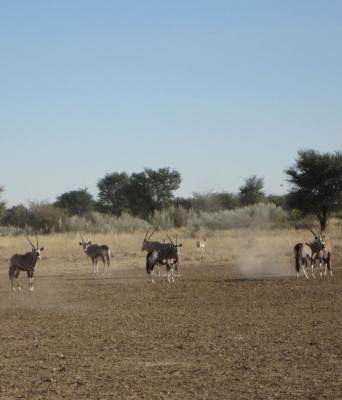

Covering about 84 percent of Botswanas land area, the semi-arid Kgalagadi terrain dominates most of the country. A land of singular, often hidden, beauty, the Kgalagadi is intensely alive with an astonishing diversity of plant and animal life.
It has broad variations in vegetation, supporting several savanna types, namely grass, shrub and tree savanna.
Kgalagadi Transfrontier Park
The Gemsbok National Park (Botswana) and the Kalahari Gemsbok Park (South Africa have been formed into one unit creating the Kgalagadi Transfrontier Park.
The absence of man-made barriers (except to the west and south of the Park) has provided a conservation area large enough to maintain examples of two ecological processes that were once widespread in the savannahs and grasslands of Africa. The large scale migratory movements of wild ungulates; and predation by large mammalian carnivores.
It is a vast area of unspoilt countryside with low vegetation-covered dunes, grasslands, scrub bush and woodlands. Its pans are bordered by high peripheral dunes. The pans fill up with water during the rainy season and contain nutrient-rich soils, and salts.
In the southern part of near Bokspits, are large, red dunes which are a spectacle to watch and a challenge to climb. Because of its tough terrain, many parts remain virgin waiting to be experienced.
Accommodation
The reserve in the Botswana side has no facilities and the visitor must be entirely self sufficient. There are, as yet, no roads in the Botswana side.
Once in the Park, however, all game viewing is done on roads technically in South Africa, which are maintained by the South African Parks Board. On the South African side, the Kgalagadi Accommodation options include six different camps of varying size, facilities and cost.
Here, the dune systems are more pronounced, vegetation stunted, and the famous real Kalahari sand more visible. All of these, including large numbers of game are well-worth seeing; something made a little easier by the roads and low vegetation.
Wildlife
Despite this dryness and low rainfall, the Kalahari supports a diverse and abundant mammal fauna. The best time to visit the park is towards the end of the rainy season, roughly March to May, however, game can he seen at any time of the year.
The area supports numerous Kalahari ungulates which include wildebeest, eland, hartebeest, gemsbok and springbok, and a healthy population of large predators - lions, leopards, cheetah and hyena.
How to get there
The most accessible entrance is from South Africa at Twee Rivieren - please see Kgalagadi Transfrontier Park
Entry into the central Botswana area can be done via five international border posts situated on the border with South Africa - Bray, Makopong, McCarthy's Rust, Middlepits and Bokspits.
From Namibia, the Kalahari could be reached through Mamuno borderpost in the Ghanzi District some 110km away.



